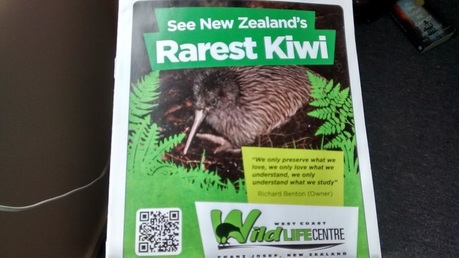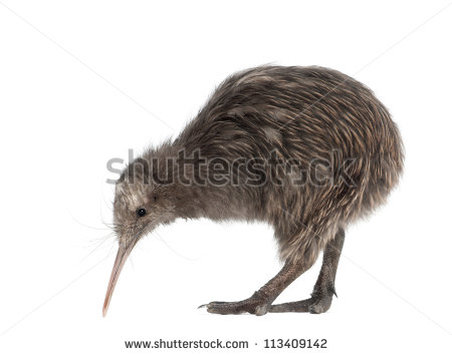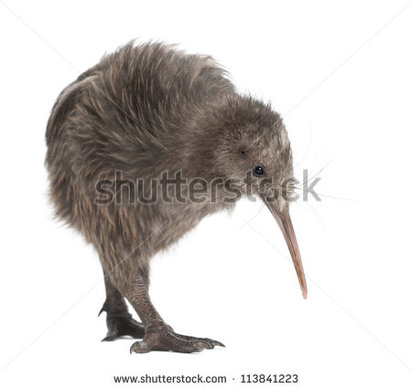- Kiwi are nocturnal, flightless birds only found in New Zealand.
- They can live for fifty to seventy years, if a predator doesn’t grab them...
- There are five different species: Great Spotted, Little Spotted, North Island Brown, Tokoeka and Rowi.
- They lay huge eggs, about 20% of the female’s bodyweight (the equivalent of a human female giving birth to a six-year-old child!)
ALL kiwi are endangered :( This is because every single species in New Zealand – the land of the birds! – evolved without terrestrial mammalian predators; their only predators were other birds. Once upon a time, New Zealand had only three native mammals! All of them were species of bat. Unfortunately, it couldn’t last... humans arrived, bringing with them a whole collection of predators, which have ravaged Kiwi populations. First the Maori, 730 years ago, brought rats and dogs, and then Europeans (370 years ago) inflicted on NZ a barrage of four-legged creatures: cats, rabbits, weasels, stoats, ferrets, pigs, possums, hedgehogs and deer. This pretty much kicked off an ongoing nightmare for New Zealand’s delicate native flora and fauna...
| The stoat, originally introduced by the Europeans in the 1880s to control rabbits (which they had also thought a good idea at the time... why did people not learn?), is now the kiwi’s main predator in forests. A stoat can kill a kiwi that weighs less than about 1 kg, and kiwi take about 12 months to reach this pivotal, life-saving weight. If a kiwi makes it to a year old, it will defend itself against a predator not with its bill but with sharp claws and thick, strong legs, and will probably survive. They can in fact run really fast, and easily outrun a human! If left to the mercy of nature, only about 50% of kiwi eggs hatch in the forest. Of this lucky 50%, only about 5% will make it to the 1 kg milestone and beyond, into adulthood, to start breeding. The West Coast Wildlife Centre is playing a crucial role in helping save the kiwi. At the moment they have two Rowi, one of the most critically endangered of the five kiwi species (there are only about 380 left) and one whose natural habitat is very local: the 11,000 hectare Okarito Sanctuary just 15km from Franz Josef. |
- New Zealand’s national Department of Conservation (DOC) monitors breeding kiwi in the wild using a radio transmitter. They usually only monitor the male in a pair, as he does most of the egg incubation (how refreshing!).
- The transmitter emits a different signal depending on how active the kiwi is. If the kiwi is moving around all night (about 8 hours), the signal emitted reflects this and the team know the kiwi is spending his nights foraging for food. However, if the kiwi is moving for only about 2 hours a night, this means he’s incubating an egg for the other 6 hours. Clever deduction work :) The transmitter then sends out a different signal, which lets the team know that there’s an egg!
- Next, a couple of DOC rangers go into the forest, transmitter in hand, to track the signal right the way to the source. After a bit of gentle prodding, they’ll find the entrance to the incubating kiwi’s burrow, and with the softest possible grip, remove the egg very slowly, being careful not to turn it. They pack it carefully into a container and transport it to the West Coast Wildlife Centre, away from predators.
- At the Centre the egg is incubated for about 80 days, and after the chick has hatched it is hand-raised initially, before being transferred to an indoor forest-like environment. This will be as similar as possible to the birds’ natural forest habitat, but with one big difference: no predators!
- After a year, when a young kiwi has reached its “safe weight” of at least 1 kg, it is released back into the same part of the forest that the egg was taken from.
| And the tourist’s eye view? :) On my visit to the Centre, I passed through two sets of heavy doors into a room that’s dark except for dim red lighting. Kiwi can’t see the colour red, so they think it’s night; in fact their day and night in the Centre is the opposite to outdoors! As kiwi are nocturnal, it’s good to have them active in “our” daytime so that tourists can see them more easily and Centre staff can monitor their behaviour. You keep absolutely silent in the red-lit room – or as near as possible. Your eyes gradually adjust and suddenly, there’s a kiwi – two! – right in front of you! Their forest-replica enclosure is huge, about 30 metres long and three deep, and you can spend many minutes just watching the two birds happily foraging in the leaf litter, scampering around, nuzzling each other etc. Adorable! They come really close to the glass barrier; I think they know they’re being watched and are not scared but curious. Here’s hoping that the DOC’s superb program runs for a good long while and goes on to save many more of NZ’s iconic little charmers! http://www.doc.govt.nz/nature/native-animals/birds/birds-a-z/kiwi/rowi/ |



 RSS Feed
RSS Feed
